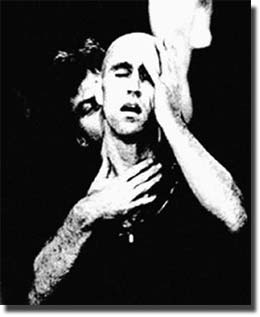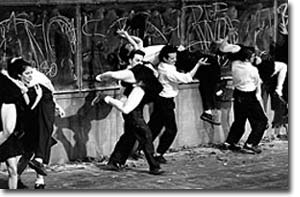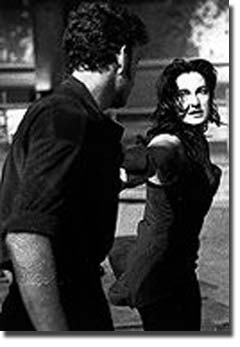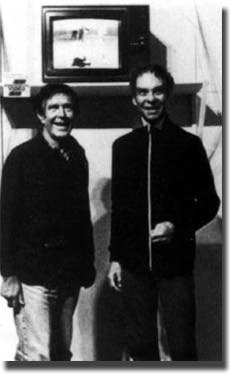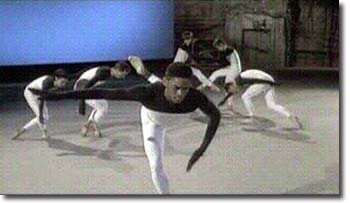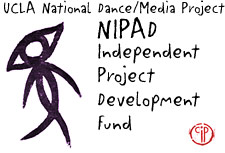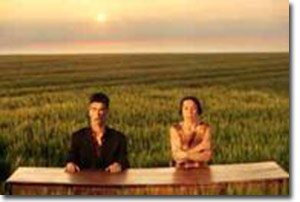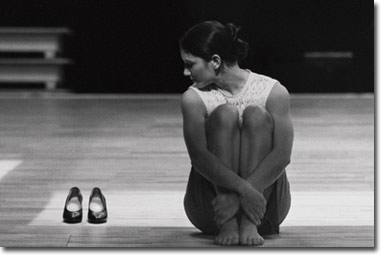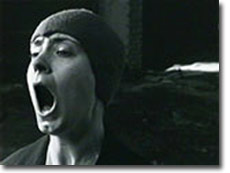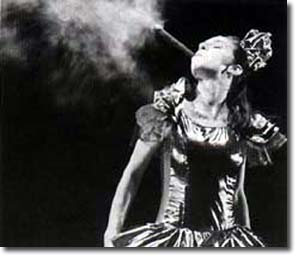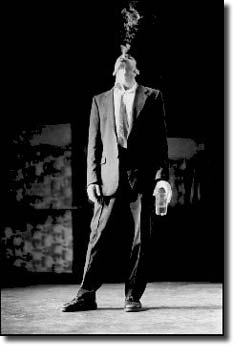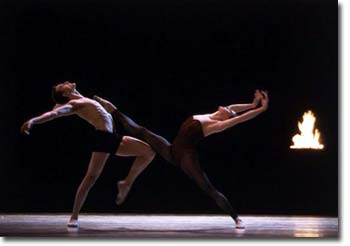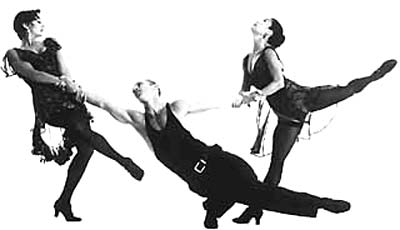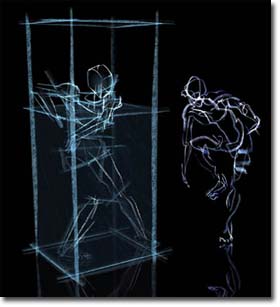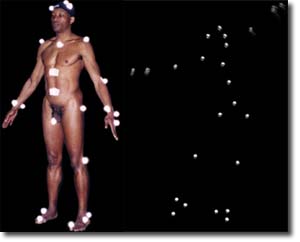|
|
1990 |
Dead Dreams of Monochrome Men, choreographed by Lloyd Newson/DV8, is reworked perceptively for the screen by director David Hinton.
|
|
| In the televised version of Le Dortoir, choreographed by Danielle Tardif, Gilles Maheu, and Carhone 14 Dance Company, the inmates of a dormitory discover sex and love, God and death. |
|
|
1991 |
In Roseland, choreographed by Wim Vandekeybus and directed by Walter Verdin, dancers in a fascinating old building take chances and move in a very fluid way.
|
|
Elliot Caplan directs Cage/Cunningham, a documentary about the remarkable partnership of Merce Cunningham and John Cage. |
|
|
1992 |
A 35mm, wide-screen camera version of stage work, Beach Birds for Camera, choreographed by Merce Cunningham and directed by Elliot Caplan, begins in black and white and moves seamlessly to color, preserving the integrity of the original while adding the clarity of Caplan's vision.
|
|
Peter Greenaway's visually arresting film Rosas, choreographed by Anne Teresa de Keersmaeker, is a woman's solo filmed in the empty foyer of the Ghent Opera in contrast black and white, with 35mm resolution and depth of field. |
|
| The Dance Heritage Coalition is founded to provide the public access to dance materials, to continue documentation of dance employing both traditional methods and developing technologies, to preserve existing documentation, and to provide education regarding methods, standards, and practice for access, documentation, and preservation.www.danceheritage.org. |
The ongoing "Dance For The Camera" series is launched by the Arts Council of England (ACE) and BBC by Bob Lockyer and Rodney Wilson. Original dance films are made col-laboratively by teams of choreographers and directors for television. |
|
1993 |
The National Initiative to Preserve America's Dance (NIPAD) is launched with a grant from the Pew Charitable Trusts. Through its grantmaking and communication activities, NIPAD's mission is to foster America's dance legacy by supporting dance documentation and preservation as an integral and ongoing part of the creation, transmission, and performance of dance.
|
|
| Le P'tit Bal, choreographed and directed by Philippe Decoufle and performed by him and Pascale Houbin, is a gem of a film about emotions portrayed through controlled movement. |
|
| Risible Chick, choreographed by Leslie Lindsay and directed by Nick de Pencier. |
Dancing, an eight-episode documentary series, developed and produced by Rhoda Grauer, includes dance traditions of eighteen different cultures. |
|
1994 |
Achterland, choreographed and directed by Anne Teresa de Keersmaeker and performed by her company Rosas, is a film of astonishing contrasts and dynamics, neatly captured by the camera and the editing.
|
|
| Outside In is supported by the Arts Council of England's "Dance for the Camera" series. Choreographed by Victoria Marks for six differently abled dancers from London's CandoCo, the film is directed by Margaret Williams. |
| Mothers and Daughters by Victoria Marks and Margaret Williams. |
| Touched, another "Dance for the Camera" film, is choreographed by Wendy Houston and directed by David Hinton. The sense of people in a bar, interacting in a claustrophobic, choreographed manner, is both captured and created by the camera |
|
1995 |
Sony offers the first "affordable," consumer-oriented digital video camcorders, with a direct line to nonlinear editing systems and lossless multigenerational editing, independent production seems to be on the horizon.
|
| Frederick Wiseman's Ballet, a documentary, compresses ten weeks of rehearsal and touring with American Ballet Theatre. |
Donald McKayle, Carolyn Adams, and Julie Strandberg create the Rainbow Etude, based on McKayle's masterwork Rainbow 'Round My Shoulder, as part of the Etude Project of the American Dance Legacy Institute. |
|
The village trilogy, choreographed, directed, and produced by Laura Taler. |
|
| Falling Down Stairs, produced by Rhombus Media, intimately chronicles a collaboration between Mark Morris and Yo-Yo Ma. |
| Boy, choreographed by Rosemary Lee and directed by Peter Anderson, is commissioned by the BBC and the Arts Council of England as part of the "Dance for the Camera" series. |
|
| Hands also commissioned by the "Dance for the Camera" series, choreographed and performed by Jonathan Burrows, is a movement exploration using only hands. |
| The George Balanchine Foundation Video Archives is initiated. |
|
1996 |
Mats Ek's Carmen, directed by Gunilla Wallin, is an imaginative treatment of unusual choreography.
|
|
| Enter Achilles, choreographed by Lloyd Newson and directed by Clara van Gool, is a strong narrative, mixing reality and fantasy. The dance movement and natural gesture are enhanced by interaction with the camera and editing. |
|
In CRWDSPCR, directed by Elliot Caplan, Merce Cunningham choreographs using the computer program LifeForms. |
| Lodela, choreographed by Jose Navas and directed by Philippe Baylaucq, is an arresting duet inspired by The Tibetan Book of the Dead. |
|
1997 |
Bella Figura, choreographed by Jiri Kylian and directed by Hans Hulscher, is the culmination of a collaboration beginning with the stage films of Kylian' s early works Sinfonietta, Symphony of Psalms, and Soldiers' Mass. With totally unobtrusive camera work and editing, the choreographic design and the dynamics of the performance are always preserved. |
|
|
1998 |
Matthew Diamond's Oscar-nominated documentary Dancemaker follows Paul Taylor and his dance company from rehearsal to a tour through India and a New York season threatened by a strike.
|
|
The first UCLA National Dance/Media Fellowship Program is launched by the UCLA Center for Intercultural Performance. Over three years (1998-2000), the program admits accomplished professionals and UCLA graduate students from the field of dance/media to develop sophisticated, practical models for dance documentation that can be disseminated to and duplicated by other individuals and institutions. |
|
1999 |
A Midsummer Night's Dream, choreography by George Balanchine, performed by the Pacific Northwest Ballet, directed by Ross MacGibbon, filmed for High Definition TV. |
Dennis Diamond, one of the original video archivists in New York, begins offering Quicktime video clips of dance companies for the Internet. |
| Bill T. Jones collaborates with Paul Kaiser and Shelley Eshkar on Ghostcatching, an innovative virtual dance created using motion capture technology. |
|
|
Sistersister choreographed by Susana Szperling and directed by Silvina Szperling (Argentina). |
|
